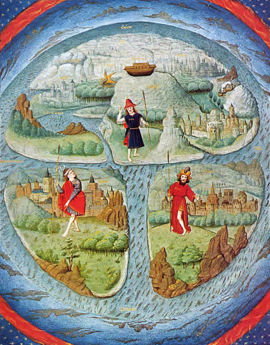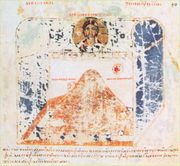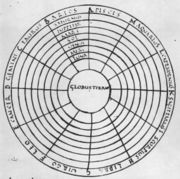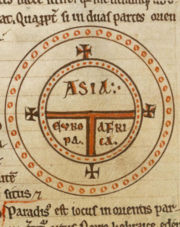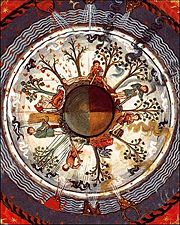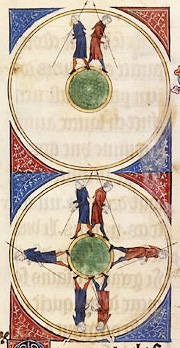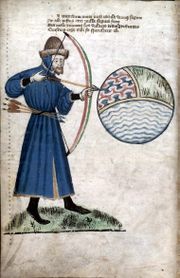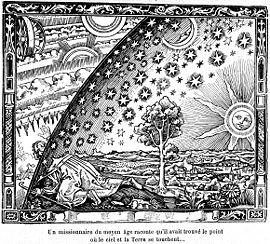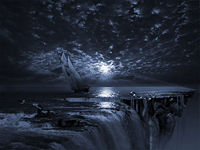Flat Earth
2008/9 Schools Wikipedia Selection. Related subjects: Myths; Religious disputes
The idea of a flat Earth is that the surface of the Earth is flat (a plane), rather than the view that it is a very close approximation of the surface of a sphere. This was a common belief until the Classical Greeks began to discuss the Earth's shape about the 4th century BC.
Regardless of the Earth's actual shape, local regions of its surface can be considered approximately flat for many purposes. The large-scale shape of the Earth is only relevant when considering large distances. Consequently, in antiquity only sailors, astronomers, philosophers, and theologians would have been concerned about the Earth's large-scale shape.
The modern belief that especially medieval Christianity believed in a flat earth has been referred to as The Myth of the Flat Earth. In 1945, it was listed by the Historical Association (of Britain) as the second of 20 in a pamphlet on common errors in history. Recent scholarship has argued that "with extraordinary [sic] few exceptions no educated person in the history of Western Civilization from the third century B.C. onward believed that the earth was flat" and that the prevailing view was of a spherical earth.
Jeffrey Russell states that the modern view that people of the Middle Ages believed that the Earth was flat is said to have entered the popular imagination in the 19th century, thanks largely to the publication of Washington Irving's fantasy The Life and Voyages of Christopher Columbus in 1828. Although these writers reject the idea of a flat earth, others such as the Flat Earth Society accept or promote the hypothesis.
Validity and usefulness
Regardless of whether the entire earth is flat or not, the surface of the Earth can be approximated as flat over small distances. Assuming the whole earth to be flat was actually a sophisticated insight by primitive people: they realized that all the local accidents of geography: hills, valleys, rivers, and so on, were merely unevennesses of a surface which was on average flat as far as they could go. When surveying and direction-finding we assume that the angles of a triangle add up to 180°, which is not true for a triangle on the surface of a sphere.
Antiquity
Belief in a flat Earth is found in mankind's oldest writings. In early Mesopotamian thought, the world was portrayed as a flat disk floating in the ocean, and this forms the premise for early Greek maps such as those of Anaximander and Hecataeus of Miletus.
Some theologians and biblical researchers maintain that at least some of the writers of the Old Testament books of the Bible had a Babylonian world view, according to which Earth is flat and stands on pillars, and is covered by a solid sky-dome (the Firmament). The firmament was the heaven in which God set the sun ( Psalm 19:5) and the stars ( Gen 1:14). The flat earth concept appears to be mentioned in ( Isaiah 40:22) where it speaks of God "dwelling above the circle of earth" which means a literal circle, from the Hebrew word "chuwg". However in Isaiah 22:18, the word "duwr" is used to describe a ball. This would appear to be in conflict with the Babylonian world view. Job 26:7 states that God was "hanging the earth upon nothing" and the same verse also described the north (of the Earth) as hanging over nothing too. The non-canonical Book of Enoch presents a concept In which the Sun and Moon move in and out of the Firmament dome through a series of openings (reflecting the apparent movement of their rising and setting points throughout the year). This is explained in considerable detail in the following excerpt:
- "This is the first commandment of the luminaries: The sun is a luminary whose egress is an opening of heaven, which is (located) in the direction of the east, and whose ingress is (another) opening of heaven, (located) in the west. I saw six openings through which the sun rises and six openings through which it sets. The moon also rises and sets through the same openings, and they are guided by the stars; together with those whom they lead, they are six in the east and six in the west heaven. All of them (are arranged) one after another in a constant order. There are many windows (both) to the right and the left of these openings. First there goes out the great light whose name is the sun; its roundness is like the roundness of the sky; and it is totally filled with light and heat. The chariot in which it ascends is (driven by) the blowing wind. The sun sets in the sky (in the west) and returns by the northeast in order to go to the east; it is guided so that it shall reach the eastern gate and shine in the face of the sky" (1 Enoch 72:2-5).
Classical Antiquity
By classical times the idea that Earth was spherical began to take hold in Ancient Greece. Pythagoras in the 6th century BC, apparently on aesthetic grounds, held that all the celestial bodies were spherical. However, most Presocratic Pythagoreans considered the world to be flat. According to Aristotle, pre-Socratic philosophers, including Leucippus (c. 440 BC) and Democritus (c. 460-370 BC) believed in a flat earth. Anaximander believed the Earth to be a short cylinder with a flat, circular top which remained stable because it is the same distance from all things. It has been suggested that seafarers probably provided the first observational evidence that the Earth was not flat.
Around 330 BC, Aristotle provided observational evidence for the spherical Earth, noting that travelers going south see southern constellations rise higher above the horizon. He argued that this was only possible if their horizon was at an angle to northerners' horizon and thus the Earth's surface could not be flat. He also noted that the border of the shadow of Earth on the Moon during the partial phase of a lunar eclipse is always circular, no matter how high the Moon is over the horizon. Only a sphere casts a circular shadow in every direction, whereas a circular disk casts an elliptical shadow in all directions apart from directly above and directly below. Writing around 10 BC, the Greek geographer Strabo cited various phenomena observed at sea as suggesting that the Earth was spherical. He observed that elevated lights or areas of land were visible to sailors at greater distances than those which were less elevated, and stated that the curvature of the sea was obviously responsible for this. He also remarked that observers can see further when their eyes are elevated, and cited a line from the Odyssey as indicating that the poet Homer was already aware of this as early as the 7th or 8th century BC.
The Earth's circumference was first determined around 240 BC by Eratosthenes. Eratosthenes knew that in Syene, in Egypt, the Sun was directly overhead at the summer solstice, while he estimated that a shadow cast by the Sun at Alexandria was 1/50th of a circle. He estimated the distance from Syene to Alexandria as 5,000 stades, and estimated the Earth's circumference was 250,000 stades and a degree was 700 stades (implying a circumference of 252,000 stades). Eratosthenes used rough estimates and round numbers, but depending on the length of the stadion, his result is within a margin of between 2% and 20% of the actual circumference, 40,008 kilometres. Note that Eratosthenes could only measure the circumference of the Earth by assuming that the distance to the Sun is so great that the rays of sunlight are essentially parallel. A similar measurement, reported in a Chinese mathematical treatise, the Zhoubi suanjing (1st c. BC), was used to measure the distance to the Sun– albeit by assuming that the Earth was flat.
Lucretius (1st. c. BC) opposed the concept of a spherical Earth, because he considered the idea of antipodes absurd. But by the 1st century AD, Pliny the Elder was in a position to claim that everyone agrees on the spherical shape of Earth, although there continued to be disputes regarding the nature of the antipodes, and how it is possible to keep the ocean in a curved shape. Pliny also considers the possibility of an imperfect sphere, "shaped like a pinecone".
In the Second century the Alexandrian astronomer Ptolemy advanced many arguments for the sphericity of the Earth. Among them was the observation that when sailing towards mountains, they seem to rise from the sea, indicating that they were hidden by the curved surface of the sea. He also gives separate arguments that the Earth is curved north-south and that it is curved east-west. Ptolemy derived his maps from a curved globe and developed the system of latitude, longitude, and climes. His writings remained the basis of European astronomy throughout the Middle Ages, although Late Antiquity and the Early Middle Ages (ca. 3rd to 7th centuries) saw occasional arguments in favour of a flat Earth.
In late antiquity such widely read encyclopedists as Macrobius (4th c.) and Martianus Capella (5th c.) discussed the circumference of the sphere of the Earth, its central position in the universe, the difference of the seasons in northern and southern hemispheres, and many other geographical details. In his commentary on Cicero's Dream of Scipio, Macrobius described the Earth as a globe of insignificant size in comparison to the remainder of the cosmos.
India
From antiquity, a cosmological view prevailed in India that held the Earth to consist of four continents grouped around the central mountain Meru like the petals of a flower; surrounding these continents was the outer ocean. This view was elaborated in traditional Buddhist cosmology, which depicts the world as a vast, flat oceanic disk (of the magnitude of a small planetary system), bounded by mountains, in which the continents are set as small islands. In the centre of this disk is the immense Mount Sumeru, the linchpin of the world, around which the stars, the Sun, and the Moon revolve; the change of day and night is caused by the occultation of the Sun by this mountain. This world is only one of an infinite number of similar worlds, which extend in all directions.
China and the Far East
In ancient China, the prevailing belief was that the earth was flat and square, while the Heavens were round, an assumption which remained dominant until the introduction of European astronomy in the 17th century.
In the Han Dynasty (202 BC-220 AD) text of the Da Dai Li Ji (大戴禮記) (Records of Ritual Matters by Dai Senior), it quotes the earlier Zeng Shen (505 BC-436 BC) replying to a question of Shanchu Li, admitting that it was hard to conceptualize the orthodox Chinese view of the four corners of the earth and how they could be properly covered. Earlier conjectures that Zhang Heng (78-139 AD) theorized that the universe was in the oval shape of a hen's egg, and the earth itself was like the curved yolk within, have been refuted by the English sinologist Cullen:
In a passage of Zhang Heng's cosmogony not translated by Needham, Chang himself says: "Heaven takes its body from the Yang, so it is round and in motion. Earth takes its body from the Yin, so it is flat and quiescent". The point of the egg analogy is simply to stress that the earth is completely enclosed by heaven, rather than merely covered from above as the kai t'ien describes. Chinese astronomers, many of them brilliant men by any standards, continued to think in flat-earth terms until the seventeenth century; this surprising fact might be the starting-point for a re-examination of the apparent facility with which the idea of a spherical earth found acceptance in fifth-century B.C. Greece.
In the 17th century, due to the influence of the Jesuits, who held high positions as astronomers at the Chinese court, the idea of a spherical earth spread in Chinese. Thus, shortly after the collapse of the Ming Dynasty, the Ge Chi Cao treatise of Xiong Ming-yu was written (1648 AD), and showed a printed picture of the earth as a spherical globe, with the text stating that "The Round Earth certainly has no Square Corners". The text also pointed out that sailing ships could return to their port of origin after circumnavigating the waters of the earth. Xiong Ming-yu, in order to persuade the elite class of his time, harkened back to ideas of the Hun Tian theorists to defend his ideas, with the earth 'as round as a crossbow bullet' ('yuan ru dan wan').
The influence of the map is distinctly Western, as traditional maps of Chinese cartography held the graduation of the sphere at 365.25 degrees, while the Western graduation was of 360 degrees. Also of interest to note is on one side of the world, there is seen towering Chinese pagodas, while on the opposite side (upside-down) there were European cathedrals. Western influence of geographical knowledge was used by Xiong to enforce what he believed had already been argued by earlier Chinese astronomers. However, the French sinologist Jean-Claude Martzloff regards this as a retrospective interpretation:
European astronomy was so much judged worth consideration that numerous Chinese authors developed the idea that the Chinese of antiquity had anticipated most of the novelties presented by the missionaries as European discoveries, for example, the rotundity of the earth and the “heavenly spherical star carrier model.” Making skillful use of philology, these authors cleverly reinterpreted the greatest technical and literary works of Chinese antiquity. From this sprang a new science wholly dedicated to the demonstration of the Chinese origin of astronomy and more generally of all European science and technology.
In a more recent work reviewing Needham's hypotheses, the English scholar Cullen emphasizes the point that there was actually no concept of a round earth in ancient Chinese astronomy:
A century later Chiang Chi attempted to meet the objection with a hypothesis of the curvilinear propagation of light along the celestial sphere. Here, if at all, we might have expected to find some reference to the sphericity of the earth, but, as already noted, Chinese astronomy shows no trace of this idea.
Early Christian Church
From Late Antiquity, and from the beginnings of Christian theology, knowledge of the sphericity of the Earth had become widespread. There was some debate concerning the possibility of the inhabitants of the antipodes: people imagined as separated by an impassable torrid clime were difficult to reconcile with the Christian view of a unified human race descended from one couple and redeemed by a single Christ.
Saint Augustine (354–430) argued against assuming people inhabited the antipodes:
But as to the fable that there are Antipodes, that is to say, men on the opposite side of the earth, where the sun rises when it sets to us, men who walk with their feet opposite ours, that is on no ground credible. And, indeed, it is not affirmed that this has been learned by historical knowledge, but by scientific conjecture, on the ground that the earth is suspended within the concavity of the sky, and that it has as much room on the one side of it as on the other: hence they say that the part which is beneath must also be inhabited. But they do not remark that, although it be supposed or scientifically demonstrated that the world is of a round and spherical form, yet it does not follow that the other side of the earth is bare of water; nor even, though it be bare, does it immediately follow that it is peopled.
Since these people would have to be descended from Adam, they would have had to travel to the other side of the Earth at some point; Augustine continues:
It is too absurd to say, that some men might have taken ship and traversed the whole wide ocean, and crossed from this side of the world to the other, and that thus even the inhabitants of that distant region are descended from that one first man.
Scholars of Augustine's work have traditionally assumed that he would have shared the common view of his educated contemporaries that the earth is spherical. That assumption has recently been challenged, however.
Some authors and artists less prominent in the Church's history directly opposed the round Earth. After his conversion to Christianity, Lactantius (245–325) became a trenchant critic of all pagan philosophy. In Book III of The Divine Institutes he ridicules the notion that there could be inhabitants of the antipodes "whose footsteps are higher than their heads". After presenting some arguments which he claims advocates for a spherical heaven and earth had advanced to support their views, he writes:
But if you inquire from those who defend these marvellous fictions, why all things do not fall into that lower part of the heaven, they reply that such is the nature of things, that heavy bodies are borne to the middle, and that they are all joined together towards the middle, as we see spokes in a wheel; but that the bodies which are light, as mist, smoke, and fire, are borne away from the middle, so as to seek the heaven. I am at a loss what to say respecting those who, when they have once erred, consistently persevere in their folly, and defend one vain thing by another;
In his Homilies Concerning the Statutes St. John Chrysostom (344–408) explicitly espoused the idea, based on his reading of Scripture, that the Earth floated on the waters gathered below the firmament, and St. Athanasius (c.293–373) expressed similar views in Against the Heathen, though in context he is clearly speaking of the landmasses of the earth floating upon the ocean. As he supports the assumption in chapter 27 that the Sun revolves around the earth, this is unlikely to be support for a flat earth. Diodorus of Tarsus (d. 394) also argued for a flat Earth based on scriptures; however, Diodorus' opinion on the matter is known to us only by a criticism of it by Photius. Severian, Bishop of Gabala (d. 408), wrote: "The earth is flat and the sun does not pass under it in the night, but travels through the northern parts as if hidden by a wall". The Egyptian monk Cosmas Indicopleustes (547) in his Topographia Christiana, where the Covenant Ark was meant to represent the whole universe, argued on theological grounds that the Earth was flat, a parallelogram enclosed by four oceans.
At least one early Christian writer, Basil of Caesarea (329–379), believed the matter to be theologically irrelevant.
In the Middle Ages
Early Medieval Europe
With the end of Roman civilization, Western Europe entered the Middle Ages with great difficulties that affected the continent's intellectual production. Most scientific treatises of classical antiquity (in Greek) were unavailable, leaving only simplified summaries and compilations. Still, the dominant textbooks of the Early Middle Ages supported the sphericity of the Earth. For example: many early medieval manuscripts of Macrobius include maps of the Earth, including the antipodes, zonal maps showing the Ptolemaic climates derived from the concept of a spherical Earth and a diagram showing the Earth (labeled as globus terrae, the sphere of the Earth) at the centre of the hierarchically ordered planetary spheres. Further examples of such medieval diagrams can be found in medieval manuscripts of the Dream of Scipio. In the Carolingian era, scholars discussed Macrobius's view of the antipodes. One of them, the Irish monk Dungal, asserted that the tropical gap between our habitable region and the other habitable region to the south was smaller than Macrobius had believed.
Europe's view of the shape of the Earth in Late Antiquity and the Early Middle Ages may be best expressed by the writings of early Christian scholars:
- Boethius (c. 480 – 524), who also wrote a theological treatise On the Trinity, repeated the Macrobian model of the Earth as an insignificant point in the centre of a spherical cosmos in his influential, and widely translated, Consolation of Philosophy.
- Bishop Isidore of Seville (560 – 636) taught in his widely read encyclopedia, the Etymologies, that the Earth was round. His meaning was ambiguous and some writers think he referred to a disc-shaped Earth; his other writings make it clear, however, that he considered the Earth to be globular. He also admitted the possibility of people dwelling at the antipodes, considering them as legendary and noting that there was no evidence for their existence. Isidore's disc-shaped analogy continued to be used through the Middle Ages by authors clearly favouring a spherical Earth, e.g. the 9th century bishop Rabanus Maurus who compared the habitable part of the northern hemisphere (Aristotle's northern temperate clime) with a wheel, imagined as a slice of the whole sphere.
- The monk Bede (c.672 – 735) wrote in his influential treatise on computus, The Reckoning of Time, that the Earth was round, explaining the unequal length of daylight from "the roundness of the Earth, for not without reason is it called 'the orb of the world' on the pages of Holy Scripture and of ordinary literature. It is, in fact, set like a sphere in the middle of the whole universe." ( De temporum ratione, 32). The large number of surviving manuscripts of The Reckoning of Time, copied to meet the Carolingian requirement that all priests should study the computus, indicates that many, if not most, priests were exposed to the idea of the sphericity of the Earth. Ælfric of Eynsham paraphrased Bede into Old English, saying "Now the Earth's roundness and the Sun's orbit constitute the obstacle to the day's being equally long in every land."
- Bishop Vergilius of Salzburg (c.700 – 784) is sometimes cited as having been persecuted for teaching "a perverse and sinful doctrine ... against God and his own soul" regarding the sphericity of the earth. Pope Zachary decided that "if it shall be clearly established that he professes belief in another world and other people existing beneath the earth, or in another sun and moon there, thou art to hold a council, and deprive him of his sacerdotal rank, and expel him from the church." The issue involved was not the sphericity of the Earth itself, but whether people living in the antipodes were not descended from Adam and hence were not in need of redemption. Vergilius succeeded in freeing himself from that charge; he later became a bishop and was canonised in the thirteenth century.
A non-literary but graphic indication that people in the Middle Ages believed that the Earth was a sphere, is the use of the orb ( globus cruciger) in the regalia of many kingdoms and of the Holy Roman Empire. It is attested from the time of the Christian late-Roman emperor Theodosius II (423) throughout the Middle Ages; the Reichsapfel was used in 1191 at the coronation of emperor Henry VI.
A recent study of medieval concepts of the sphericity of the Earth noted that "since the eighth century, no cosmographer worthy of note has called into question the sphericity of the Earth." However, the work of these intellectuals may not have had significant influence on public opinion, and it is difficult to tell what the wider population may have thought of the shape of the Earth, if they considered the question at all.
Later Medieval Europe
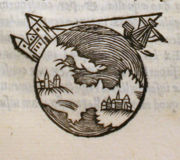
Some historians consider that the early advocates of the flat Earth were influential (19th century view typified by Andrew Dickson White); others that they were relatively unimportant (typified by Religious Studies Scholar Jeffrey Burton Russell in the 1990s) in the later Middle Ages.
By the 11th century Europe had learned of Islamic astronomy. The Renaissance of the 12th century from about 1070 started an intellectual revitalization of Europe with strong philosophical and scientific roots, and increased appetite for the study of nature. Abundant records suggest that by then Europeans generally believed that the Earth was spherical.
Hermannus Contractus (1013–1054) was among the earliest Christian scholars to estimate the circumference of Earth with Eratosthenes' method. Thomas Aquinas (1225–1274), the most important and widely taught theologian of the Middle Ages, believed in a spherical Earth; and he even took for granted his readers also knew the Earth is round. Lectures in the medieval universities commonly advanced evidence in favour of the idea that the Earth was a sphere. Also, " On the Sphere of the World", the most influential astronomy textbook of the 13th century and required reading by students in all Western European universities, described the world as a sphere. Thomas Aquinas, in his Summa Theologica, wrote, "The physicist proves the earth to be round by one means, the astronomer by another: for the latter proves this by means of mathematics, e.g. by the shapes of eclipses, or something of the sort; while the former proves it by means of physics, e.g. by the movement of heavy bodies towards the centre, and so forth."
The shape of the Earth was not only discussed in scholarly works written in Latin; it was also treated in works written in vernacular languages or dialects and intended for wider audiences. The Norwegian book Konungs Skuggsjá, from around 1250, states clearly that the Earth is round - and that it is night on the other side of the Earth when it is daytime in Norway. The author also discusses the existence of antipodes - and he notes that they (if they exist) will see the Sun in the north of the middle of the day, and that they will have opposite seasons of the people living in the Northern Hemisphere.
Dante's Divine Comedy, the last great work of literature of the Middle Ages, written in Italian, portrays Earth as a sphere, discussing implications such as the different stars visible in the southern hemisphere, the altered position of the sun, and the various timezones of the Earth. Also, the Elucidarium of Honorius Augustodunensis (c. 1120), an important manual for the instruction of lesser clergy which was translated into Middle English, Old French, Middle High German, Old Russian, Middle Dutch, Old Norse, Icelandic, Spanish, and several Italian dialects, explicitly refers to a spherical Earth. Likewise, the fact that Bertold von Regensburg (mid-13th century) used the spherical Earth as a sermonic illustration shows that he could assume this knowledge among his congregation. The sermon was held in the vernacular German, and thus was not intended for a learned audience.
Reinhard Krüger, a professor for Romance literature at the University of Stuttgart (Germany), has discovered more than 100 medieval Latin and vernacular writers - 79 known by name - from the late antiquity to the 15th century who were all convinced that the earth was round like a ball:
Authors between late antiquity and Columbus' voyage (1492) who argued for a spherical earth:
- Kings and politicians
Brunetto Latini, Visigoth king Sisebut, King Alfred of the Anglo-Saxons, Alfonso X of Castile
- Church fathers, popes, bishops, priests, members of religious orders
Basil of Caesarea, Ambrose of Milan, Aurelius Augustinus, Paulus Orosius, Jordanes, Cassiodorus, Isidore of Seville, Beda Venerabilis, Theodulf of Orléans, Vergilius of Salzburg, Irish monk Dicuil, Rabanus Maurus, Remigius of Auxerre, Johannes Scotus Eriugena, Leo of Naples, Gerbert d’Aurillac (Pope Sylvester II), Notker the German of Sankt-Gallen, Hermann the lame, Hildegard von Bingen, Petrus Abaelardus, Honorius Augustodunensis, Gautier de Metz, Adam of Bremen, Albertus Magnus, Thomas Aquinas, Berthold of Regensburg, Meister Eckhart, Enea Silvio Piccolomini (Pope Pius II)
- Theologians, philosophers and encyclopedists
Ampelius, Chalcidius, Macrobius, Martianus Capella, Boethius, Guillaume de Conches, Philippe de Thaon, Abu-Idrisi, Bernardus Silvestris, Petrus Comestor, Thierry de Chartres, Gautier de Châtillon, Alexander Neckam, Alain de Lille, Averroes, Moshe ben Maimon, Lambert de Saint-Omer, Gervasius of Tilbury, Robert Grosseteste, Johannes de Sacrobosco, Thomas de Cantimpré, Peire de Corbian, Vincent de Beauvais, Robertus Anglicus, Juan Gil de Zámora, Perot de Garbelei, Roger Bacon, Ristoro d'Arezzo, Cecco d'Ascoli, Fazio degli Uberti, Levi ben Gershon, Konrad of Megenberg, Nicole Oresme, Petrus Aliacensis, Alfonso de la Torre, Toscanelli
- Poets, travellers, printers, seafarers, merchants
Snorri Sturluson, Marco Polo, Dante Alighieri, Brochard the German, Jean de Meung, Jean de Mandeville, Christine de Pizan, Geoffrey Chaucer, William Caxton, Martin Behaim, Christopher Columbus
Portuguese exploration of Africa and Asia, Columbus voyage to the Americas (1492) and finally Ferdinand Magellan's circumnavigation of the earth (1519-21) provided the final, practical proofs for the global shape of the earth.
Islamic World
Around 830 CE, Caliph al-Ma'mun commissioned a group of astronomers to measure the distance from Tadmur ( Palmyra) to al-Raqqah, in modern Syria. They found the cities to be separated by one degree of latitude and the distance between them to be 66 2/3 miles and thus calculated the Earth's circumference to be 24,000 miles (about 38,600 km), a value which differs from modern estimates by about 3.6%.
Many Muslim scholars declared a mutual agreement ( Ijma) that celestial bodies are round, among them Ibn Hazm (d. 1069), Ibn al-Jawzi (d. 1200), and Ibn Taymiya (d. 1328). Ibn Taymiya said, "Celestial bodies are round—as it is the statement of astronomers and mathematicians—it is likewise the statement of the scholars of Islam". Abul-Hasan ibn al-Manaadi, Abu Muhammad Ibn Hazm, and Abul-Faraj Ibn Al-Jawzi have said that the Muslim scholars are in agreement that all celestial bodies are round. Ibn Taymiyah also remarked that Allah has said, "And He (Allah) it is Who created the night and the day, the sun and the moon. They float, each in a Falak." Ibn Abbas says, "A Falaka like that of a spinning wheel." The word 'Falak' (in the Arabic language) means "that which is round."
The Muslim scholars who held to the round earth theory used it in an impeccably Islamic manner, to calculate the distance and direction from any given point on the earth to Makkah (Mecca). This determined the Qibla, or Muslim direction of prayer. Muslim mathematicians developed spherical trigonometry which was used in these calculations. Ibn Khaldun (d. 1406), in his Muqaddimah, also identified the world as spherical. The later belief of Muslim scholars, like Suyuti (d. 1505), that the earth is flat represents a deviation from this earlier opinion.
Modern times
Myth of the Flat Earth
The common misconception that people before the age of exploration believed that Earth was flat entered the popular imagination after Washington Irving's publication of The Life and Voyages of Christopher Columbus in 1828. This belief is even repeated in some widely read textbooks. Previous editions of Thomas Bailey's The American Pageant stated that "The superstitious sailors [of Columbus' crew] ... grew increasingly mutinous...because they were fearful of sailing over the edge of the world"; however, no such historical account is known. Actually, sailors were probably among the first to know of the curvature of Earth from everyday observations, for example seeing how mountains vanish below the horizon on sailing far from shore.
During the 19th century, the Romantic conception of a European "Dark Age" gave much more prominence to the Flat Earth model than it ever possessed historically.
The widely circulated woodcut of a man poking his head through the firmament of a flat Earth to view the mechanics of the spheres, executed in the style of the 16th century cannot be traced to an earlier source than Camille Flammarion's L'Atmosphère: Météorologie Populaire (Paris, 1888, p. 163). The woodcut illustrates the statement in the text that a medieval missionary claimed that "he reached the horizon where the Earth and the heavens met", an anecdote that may be traced back to Voltaire, but not to any known medieval source. In its original form, the woodcut included a decorative border that places it in the 19th century; in later publications, some claiming that the woodcut dated from the 16th century, the border was removed. According to anecdotal evidence Flammarion had commissioned the woodcut himself; certainly no source of the image earlier than Flammarion's book is known.
In Inventing the Flat Earth: Columbus and Modern Historians, Jeffrey Russell (professor of history at University of California, Santa Barbara) claims that the Flat Earth theory is a fable used to impugn pre-modern civilization, especially that of the Middle Ages in Europe. Today many scholars agree with Russell that the "medieval flat Earth" was an exaggeration of Medieval beliefs, which became popular in the nineteenth-century.
It should be noted, however, that Cyrano de Bergerac in chapter 5 of his The Other World The Societies and Governments of the Moon quotes St. Augustine as saying "that in his day and age the earth was as flat as a stove lid and that it floated on water like half of a sliced orange." Robert Burton, in his The Anatomy of Melancholy wrote: " Virgil, sometimes bishop of Saltburg (as Aventinus anno 745 relates) by Bonifacius bishop of Mentz was therefore called in question, because he held antipodes (which they made a doubt whether Christ died for) and so by that means took away the seat of hell,or so contracted it, that it could bear no proportion to heaven, and contradicted that opinion of Austin [=St. Augustine], Basil, Lactantius that held the earth round as a trencher (whom Acosta and common experience more largely confute) but not as a ball;" Thus, there is evidence that accusations of flatearthism, though somewhat whimsical (Burton ends his digression with a legitimate quotation of St. Augustine: "Better doubt of things concealed, than to contend about uncertainties, where Abraham's bosom is, and hell fire:") were used to discredit opposing authorities several centuries before the 19th.
A dissenting opinion is found at the Ethical Atheist where the transition from a flat Earth model to a spherical Earth is seen as a slow and uneven process, with the general population and some of the more biblically inclined (among others) lagging centuries behind those more inclined towards science and Greek authors.
Transvaal perspective
In 1898 during his solo circumnavigation of the world Joshua Slocum encountered such a group in Durban. Three Boers, one of them a clergyman, presented Slocum with a pamphlet in which they set out to prove that the world was flat. President Kruger of the Transvaal Republic advanced the same view: "You don't mean round the world, it is impossible! You mean in the world. Impossible!"
The Flat Earth Society
The last known group of Flat Earth proponents, the Flat Earth Society, kept the concept alive and at one time claimed a few thousand followers. The last president of the Society, Charles K. Johnson, spent years examining the studies of flat and round earth theories and proposed evidence of a conspiracy against flat-earth: "The idea of a spinning globe is only a conspiracy of error that Moses, Columbus, and FDR all fought…" His article was published in the magazine Science Digest, 1980. It goes on to state, "If it is a sphere, the surface of a large body of water must be curved. The Johnsons have checked the surfaces of Lake Tahoe and the Salton Sea (a shallow salt lake in southern California near the Mexican border) without detecting any curvature."
The Society declined in the 1990s following a fire at its headquarters in California and the death of Charles K. Johnson in 2001.
Other modern flat-earthers
William Carpenter (1830-1896) published "A hundred proofs the Earth is not a Globe". For example, he argues that "there are rivers that flow for hundreds of miles towards the level of the sea without falling more than a few feet — notably, the Nile, which, in a thousand miles, falls but a foot. A level expanse of this extent is quite incompatible with the idea of the Earth's 'convexity'"; and that an aeronaut at the highest possible altitude will see what appears to be a concave surface "this being exactly what is to be expected of a surface that is truly level, since it is the nature of level surfaces to appear to rise to a level with the eye of the observer".
English scientist Samuel Rowbotham (1816-1885), writing under the pseudonym "Parallax," published results of many experiments which tested the curvatures of water over lakes. He also produced studies which purported to show the effects of ships disappearing below the horizon can be explained by the laws of perspective in relation to the human eye.
Ibn Baz controversy
One influential modern Muslim jurist has been said to have claimed that the earth is flat, and that anyone who denies this is an unbeliever. Abd-al-Aziz ibn Abd-Allah ibn Baaz (Ibn Baz), the Grand Mufti of Saudi Arabia, was a traditionally educated cleric who suffered from blindness. In 1993, he is said to have issued a fatwa, or religious ruling, declaring, "The Earth is flat. Whoever claims it is round is an atheist deserving of punishment." While the edict reportedly caused embarrassment for many Saudis, Ibn Baz issued a statement maintaining that the earth was spherical but expansive enough to be flat and saying that he "only" denied Earth's rotation.
Supporters of Ibn Baz said that the book in which the flat earth claim was supposed to have been laid out does not exist, and that the entire controversy was based on one interview with Egyptian journalists. They said that Ibn Baz, as he clarified later, was referring to the surface of earth that we walk on being flat although he believed the Earth to be spherical. In Arabic, the same word is commonly used for both the earth as well as the ground. The journalist, having not paid attention to this distinction, misquoted Ibn Baz and created a story; the story was picked up by a Kuwaiti magazine (Assiyasah) and from there spread around the world. Ibn Baz was an admirer and a scholar of the works of Ibn Taymiyyah, who did not support the flat earth theory.
